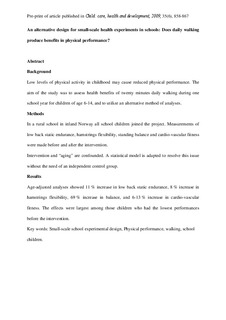An alternative design for small-scale health experiments in schools : does daily walking produce benefits in physical performance?
Journal article, Peer reviewed
Permanent lenke
http://hdl.handle.net/11250/134436Utgivelsesdato
2009Metadata
Vis full innførselSamlinger
Originalversjon
Mønness, E & Sjølie, A.N. (2009). An alternative design for small-scale health experiments in schools : does daily walking produce benefits in physical performance? Child: care, health and development, 35(6), 858-867Sammendrag
Background: The mainstream randomized clinical trial is not always feasible in a school setting. There might be practical and ethical issues that make dividing school classes into an intervention and a control group impossible or undesirable, and there is a need to explore the validity of alternative designs and analyses. Methods: An alternative to a randomized clinical trial in a physical performance experiment at a school is introduced an evaluated. The before intervention data is utilized as control data for the intervention data in addition to adjust for pre-intervention differences. The strict class-year structure of school data makes this possible. In a rural school in inland XXX1 all school children joined the project of walking in a rugged terrain outside school 20 minutes every school day during a school year. Measurements of low back static endurance, hamstrings flexibility, standing balance and cardio-vascular fitness were made before and after the intervention. Since intervention and “aging” were confounded, the special use of the pre-intervention data, “age-adjusted”, is proposed to solve this issue. A comparison with having an independent control group is performed. Results: The alternative analysing method is judged to yield valid results without having an independent control group. The age-adjusted analyses showed 11 % increase in low back static endurance, 8 % increase in hamstrings flexibility, 69 % increase in balance, and 6-13 % increase in cardio-vascular fitness. The effects were largest among those children who had the lowest performances before the intervention. Conclusion: The introduced statistical methods displays that in a school population, evaluations from an experiment can be made without an external control group. A 20-minutes walk during school time for one year seemed to improve physical performance.
